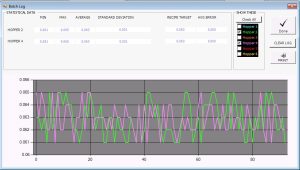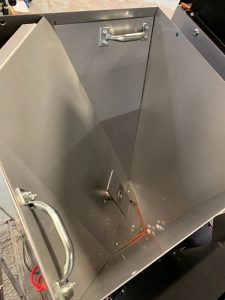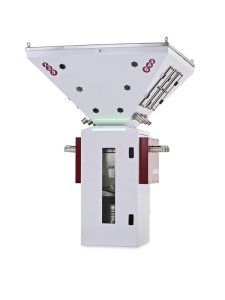
Mixing it up with regrind
Canadian Plastics
Canadian Plastics Raw Materials HandlingThe most important variables in molding are those that cause downtime and rejects if not handled properly, and the amount of regrind used in the process is definitely one of these. Which is exactly why some of the latest blenders and related technologies can handle regrind.
Whether they’re supplying centralized systems or dedicated machine blenders, blender makers are under pressure these days, and it has nothing to do with the pandemic: More and more processors are using regrind materials in order to get the most production from their resin purchases. But the problem is, these materials aren’t always easy to blend, since they may have degraded physical, chemical, and flow properties. Which means that customers expect blender makers to deliver solutions.
While the use of regrind almost always implies a blending step since it’s not normally possible to use regrind material alone, there are some specific points that should be considered when designing a blender – in particular a gravimetric blender – for regrind. “The buffer hoppers should have a bigger volume than the ones for granules, since the bulk density of regrind is generally quite low and they have a geometry designed to avoid any bridge and to make the falling of the material as regular and smooth as possible,” said Tony Rodrigues, managing director of Piovan Canada. “For very light materials, adding pneumatic bridge-breakers inside the buffer hopper, synchronized with the dosing slide gate, might be necessary to guarantee a correct flow. And special attention also has to be given to the dimensions and geometry of the slide gates passing hole, to find the right balance between the accuracy of the dosing and the best flow of the flakes.”
The good news is, a number of OEMs have accepted the challenge, as a quick look at some of the latest blending technologies shows.
A QUESTION OF CONTROL
AEC’s new BlendTrac software program can monitor and control up to 100 of the company’s BD gravimetric blenders – which will blend most free-flowing regrind materials – as well as the A-B and OA gravimetric blenders within a facility, across multiple facilities, or machines all over the country, to centralize inventory control, optimize quality, and reduce labour and material costs. Compatible with Windows 10, BlendTrac software remotely monitors the materials in each blender’s hopper and can track material reference numbers, lot numbers, and silo numbers to aid in quality control. It can log as many as 1,000 alarms per blender and up to 5,000 consecutive batch weights to monitor trends, and can be added to new AEC batch weigh blenders or installed on older models. “BlendTrac aggregates and presents blending data in a way that helps your operators reduce errors and make informed purchasing decisions,” said Michael Gersmeyer, AEC’s senior product manager.

AEC’s BlendTrac software. Photo Credit: AEC
Best known as a masterbatch specialist, Ampacet expanded its reach with its acquisition last year of auxiliary equipment maker LIAD. One result is the recent introduction of LIAD Smart BlendSave, a centralized, automated blending system that uses patented weighing and blending technology to manage resins – including regrind – and recipes for multiple processing machines. Designed for lights-out operations, it weighs ingredients individually and conveys them through dedicated lines to a mixer at each injection molding machine or extruder, and can manage up to 40 ingredients. Its automated manifold, called OctoBatch, distributes the individual ingredients of each recipe to as many as 50 buffer hoppers, one for each processing machine. The LIAD Smart BlendSave is modular, allowing additional units to be integrated to accommodate growth, Ampacet officials said, and provides total traceability and verification of raw materials in each batch formulation and real-time data management of all resin ingredients through a centralized control and a facility’s existing enterprise resource planning (ERP) system.
Conair Group’s upgraded TrueBlend gravimetric blenders, which now come with the company’s next-generation SB-5 control, can handle regrind, which can be added to the recipe and adjusted throughout the process as a percentage of the total batch size. Designed to be user-friendly, the control is easier to program and displays intuitive graphics and provides more comprehensive monitoring. “It performs on Conair’s common control interface, meaning the user experience is the same whether the user is accessing information about a blender or any other Conair equipment – such as a dryer – which simplifies operations and reduces the need for training,” said Alan Landers, Conair’s product manager, blending and upstream products. “With Conair’s feed-forward dosing algorithm, the TrueBlend blenders deliver a dosing accuracy to within 0.025 per cent for the total batch dispensed, and can manage up to 12 ingredients, dispensed from 12 material bins.” The SB-5 blender control also includes a self-loading option, Landers said, which enables users to add vacuum receivers and up to 12 loaders, as well as one pump per blender.
A BETTER BLEND
Hamilton Plastic Systems’ range of Optimix gravimetric blenders, which are applicable across all process applications and throughput requirements, are designed to offer precise mixing, dosing, weighing, and control of all materials, including regrind pellets and flakes. “Optimix batch blenders offer throughputs up to 3,000 kilograms per hour, and can accommodate up to 12 components,” said company president Steve Hamilton. “The Optimix range utilizes a slide valve design and the patented reverse flight mixing auger technology, a combination that provides superior accuracies, blend ratios, and mixing homogeneity that’s not achievable by competitive systems.”
Maguire Products’ new bridge-breaker is a pneumatically operated device that rapidly pulses between clockwise and counterclockwise movements to break up regrind and other troublesome materials that tend to clump together during the blending process. It can be deployed in the hopper of a new or existing gravimetric blender to ensure accurate dosing, according to Frank Kavanagh, Maguire’s vice president of sales and marketing, and works with the company’s three largest blenders, with capacities of up to 12 ingredients and throughputs of up to 5,000 kilograms per hour. “These bigger blenders address the growing need for introducing regrind, which is often a major component in the raw material recipe being blended,” Kavanagh said. “Regrind can account for 30 to 60 per cent of the blend – and sometimes more – and is often a light-bulk-density material, which doesn’t flow as easily as other ingredients, tending to agglomerate or bridge. It’s an especially costly problem in high-volume extrusion. With the new bridge-breaker, we’ve been able to consistently dispense bridging-prone materials at the same weight over time in batch after batch.”

Maguire Products’ new bridge-breaker. Photo Credit: Maguire Products
Motan’s Spectroflex V line of blenders, designed for introducing powders, pellets, regrind, flakes, and fibres into continuous processes, now comes with a gravimetric dosing option that features precise load cells and is controlled via a network-compatible control called GRAVInet SF. According to Motan officials, users can now easily switch between volumetric and gravimetric dosing technologies. The dosing unit’s modular design also makes material changes fast and simple, they added.
The Piovan gravimetric batch blender range, including Quantum and MDW, covers most of the applications with models from a maximum throughput of a few kilograms per hour up to three tons per hour and with a wide range of configurations and solutions, including the ones dedicated to regrind and flakes. “Quantum and batch blenders can be fully effective only when combined with a complete package designed for regrind and post-consumer flakes, such as a conveying system that can guarantee a reliable material feeding,” said Tony Rodrigues. “For applications where the batch blender isn’t applicable, Piovan Group can provide a solution as well; for example, with a continuous loss-in-weight dosing unit with a high-throughput station for flakes also from Fdm and Doteco brands.”
Wittmann’s new Gravimax G76 material blender is designed for applications requiring material throughputs of more than 700 kilograms per hour, and can handle seven kilograms per dosing cycle and blend up to six different components, including regrind. “If regrind is added to a virgin and additive and/colourant blend, the blender will account for the additives and/or colourants present in the regrind and adjust the dosed amounts, avoiding overusing these expensive materials,” said Steve Mussman, Wittmann Battenfeld USA’s division manager, material handling and auxiliaries. And the Gravimax G76 and other Wittmann blenders can monitor the level of regrind in the regrind hopper and use a high and low regrind recipe. “For example, if the level of regrind is above the sensor, the blender can dose 15 per cent regrind, but drop to 10 per cent when falling below the sensor,” Mussman said. “This will ensure regrind is always used without running out. This will provide a more consistent regrind usage, which can help achieve more consistency in the viscosity of the melt during processing, achieving more consistent part quality.”

Wimmann’s new Gravimax G76 material blender. Photo Credit: Wittmann Battenfeld
Like everything else about molding, mixing regrind is a science that requires high accuracy. These latest blenders and associated technologies can help you get there.
